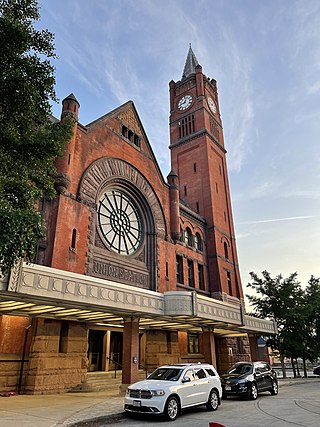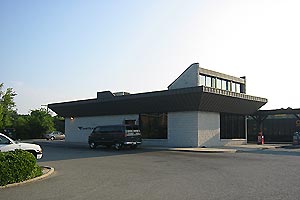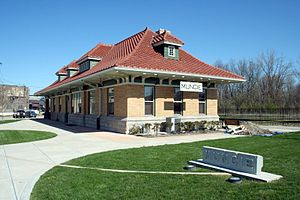
The Cardinal is a long-distance passenger train operated by Amtrak between New York Penn Station and Chicago Union Station via Philadelphia, Washington, D.C., Charlottesville, Charleston, Huntington, Cincinnati, and Indianapolis. Along with the Capitol Limited and Lake Shore Limited, it is one of three trains linking the Northeast and Chicago. Its 1,146-mile (1,844 km) trip between New York and Chicago takes 281⁄4 hours.

Richmond Main Street Station, officially the Main Street Station and Trainshed, is a historic railroad station and office building in Richmond, Virginia. It was built in 1901, and is served by Amtrak. It is also an intermodal station with Richmond's city transit bus services, which are performed by Greater Richmond Transit Company (GRTC). The station is colloquially known by residents as The Clock Tower. It was listed to the National Register of Historic Places in 1970, and in 1976 was made a U.S. National Historic Landmark. Main Street Station serves as a secondary train station for Richmond providing limited Amtrak service directly to downtown Richmond. Several Amtrak trains serving the Richmond metropolitan area only stop at the area's primary rail station, Staples Mill Road which is located five miles to the north in Henrico County.

The Union Station of Louisville, Kentucky is a historic railroad station that serves as offices for the Transit Authority of River City (TARC), as it has since mid-April 1980 after receiving a year-long restoration costing approximately $2 million. It was one of at least five union stations in Kentucky, amongst others located in Lexington, Covington, Paducah and Owensboro. It was one of three stations serving Louisville, the others being Central Station and Southern Railway Station. It superseded previous, smaller, railroad depots located in Louisville, most notably one located at Tenth and Maple in 1868–1869, and another L&N station built in 1858. The station was formally opened on September 7, 1891, by the Louisville and Nashville Railroad. There was a claim made at the time that it was the largest railroad station in the Southern United States, covering forty acres. The other major station in Louisville was Central Station, serving the Baltimore and Ohio, the Illinois Central and other railroads.

The Cardinal Greenway (TGC) is a multi-use recreational network combining a rail trail and an on-street route that together cross 62 miles (100 km) and five counties — in east central Indiana. The greenway, which was designated a National Recreation Trail in June 2003 and in 2018 was named to the Rails-to-Trails Conservancy's "Rail Trail Hall of Fame." uses the former CSX railroad track between Richmond and Marion. It is named after the Cardinal, the last regular passenger train service on the (Chicago-Cincinnati-Washington) route. Currently it is Indiana's longest rail trail project.

The George Washington was a named passenger train of the Chesapeake and Ohio Railway running between Cincinnati, Ohio and Washington, D.C. that operated from 1932, the 200th anniversary of the birth of George Washington, to 1974. A section divided from the main train at Gordonsville, Virginia and operated through Richmond to Phoebus, Virginia. From the west, a section originated in Louisville and joined at Ashland.

The Indianapolis Union Station is an intercity train station in the Wholesale District of Indianapolis, Indiana. The terminal is served by Amtrak's Cardinal line, passing through Indianapolis three times weekly.

Newport News station is an Amtrak inter-city train station in Newport News, Virginia. The station is the southern terminus of two daily Northeast Regional round trips. It has a single side platform adjacent to a large CSX rail yard. An Amtrak Thruway motorcoach connection to Norfolk station effectively doubles the frequency between each station and Washington.

Lafayette station is an Amtrak station in Lafayette, Indiana, served by the Cardinal. The current station facility was established in 1994. The Amtrak train previously stopped in the middle of the city's 5th Street, near the former Monon Railroad depot. The station building was moved to its current location from the southeast corner of 2nd and South streets in September 1994. It is a Romanesque Revival style depot built in 1902 by the Lake Erie and Western Railroad and Cleveland, Cincinnati, Chicago and St. Louis Railway, as the Big Four Depot. The station was listed on the National Register of Historic Places in 2003.

Athens station is a former train station in Athens, Ohio, adjacent to the campus of Ohio University. It served the Baltimore and Ohio Railroad from around 1890 until 1971, then Amtrak from 1976 to 1981. It is listed on the National Register of Historic Places as the Athens B & O Train Depot.

The James Whitcomb Riley was a passenger train that operated between Chicago, Illinois, and Cincinnati, Ohio, via Indianapolis, Indiana. Originally operated by the New York Central Railroad, it was taken over by Amtrak in 1971. Under Amtrak, it merged with the Chesapeake & Ohio Railway's George Washington to become a Chicago-Washington/Newport News train. In 1977, it was renamed the Cardinal, which remains in operation.

Hamilton station is a former railroad station in Hamilton, Ohio. Originally constructed by the Cincinnati, Hamilton and Dayton Railroad, which was later acquired by the Baltimore and Ohio Railroad (B&O), it was served by the B&O until 1971. Hamilton was then served by the Amtrak Cardinal from 1980 to 2005.
The Fast Flying Virginian (FFV) was a named passenger train of the Chesapeake & Ohio Railway.

Lee Hall Depot is a historic train station and museum located in the Lee Hall neighborhood of Newport News, Virginia. It was built in about 1881, with a one-story cargo bay, and the two-story main section was added in 1893. Another one-story wing was added by the Chesapeake and Ohio Railway to the north end of the depot in 1918 to handle an influx of military personnel to Fort Eustis. The building is currently in use as a local history museum, focusing on the station's history, and the history of the Chesapeake & Ohio Railroad in Warwick County.

Catlettsburg is a former Chesapeake and Ohio Railroad station located in downtown Catlettsburg, Kentucky. Opened between 1897 and 1890 to replace an older wooden station, it served trains until 1958. Amtrak trains began stopping at Tri-State Station some 1.5 miles (2.4 km) to the north in 1975; it was renamed Catlettsburg around 1988. Amtrak service was moved from Catlettsburg to Ashland in 1998. The C&O station was refurbished from 2004 to 2006 and added to the National Register of Historic Places in 2012.

The Chesapeake & Ohio Railway Station is a railway depot located in Pioneer Park on West Lake Street in Petoskey, Michigan. It was placed on the National Register of Historic Places in 1970. The building now houses the Little Traverse Historical Museum.

The Colonial was an Amtrak intercity passenger train that operated between Boston, Massachusetts, and Newport News, Virginia, from 1976 to 1992. It was introduced on June 15, 1976, to replace the lightly-used Charlottesville-Newport News section of the James Whitcomb Riley. Certain trips were known as the Senator and Tidewater beginning in the late 1970s. The Richmond-New York City Virginian was added in 1984, with some trips called Potomac from 1985 to 1988.

Grand Rapids Union Station was a union station in Grand Rapids, Michigan. A Georgian Revival building of two stories, it was built in 1900 on 61 Ionia Avenue SW and was closed in 1958. The building was demolished in 1958 and 1959 to make space for the U.S. Route 131 highway.
Gary, formerly Miller, was a train station in the Miller Beach neighborhood of Gary, Indiana.

Muncie Union Station was a passenger railroad station in Muncie, Indiana at 630 South High Street. As a union station, in earlier decades it served the Cleveland, Cincinnati, Chicago and St. Louis Railway and the New York, Chicago and St. Louis Railroad. Made of limestone, it was built in 1883 in the Romanesque Revival style, for the CCC & St. L. Other stations in Muncie served the Chesapeake and Ohio Railroad, the Muncie Street Railway and the Pennsylvania Railroad.

Delaware Big Four Depot was completed in 1887 by the Cleveland, Columbus, Cincinnati and Indianapolis Railway (CCC&I). The brick structure is in Delaware, Ohio, on the east side of the Olentangy River, and opposite side of the river from Ohio Wesleyan University. The building was a successor to an earlier frame structure built in the 1850s.





















